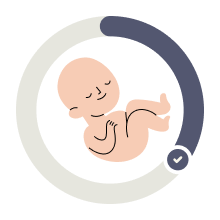You’ve entered Week 10 of your pregnancy, which marks a significant milestone as you are one-quarter of the way through. However, this week may also bring about new concerns. Fortunately, experts can provide guidance to help you overcome any challenges. Additionally, there are many enjoyable aspects of pregnancy that you have yet to encounter.
Pregnancy Week 10 Quick Facts
- At 10th weeks, you’ve entered your third month of pregnancy
- You have 30 weeks until your due time “Calculate your due date”
- You’re in the first trimester
Your Unborn Baby’s Size at 10 Weeks
During the 10th week of your pregnancy, your developing baby is approximately 1.22 inches long and weighs around 0.14 ounces, which is about the size of a prune or a strawberry!
Pregnancy Symptoms Week 10
During the 9th and 10th weeks of pregnancy, you may experience some similar symptoms, such as fatigue, nausea, vomiting, food cravings or aversions, and breast tenderness.
However, during week 10, your symptoms may become more pronounced. For example, your nausea and vomiting may be more frequent or intense, and you may experience more food aversions. You may also notice increased bloating and constipation during this time. Additionally, some women may begin to experience skin changes, such as acne or darkening of the nipples. It’s important to continue taking care of yourself and consulting with your healthcare provider about any concerns you may have.
Maybe there are some similarities in symptoms between the previous week and 10th weeks of pregnancy, because each week represents a unique stage of growth for mother and developing baby.
Prenatal Tests and Doctor’s Appointments
Single and Twin’s Baby development
- At the 10th week of pregnancy, both single and twin pregnancies typically involve several prenatal tests and doctor’s appointments.
- For a single pregnancy, a healthcare provider may recommend or perform the following:
- Some Blood tests to check for anemia, blood type, and Rh factor.
- Urine tests to check for protein, sugar, and signs of infection.
- Ultrasound to confirm the due date, check for fetal heartbeat, and evaluate fetal development.
- Genetic testing (depending on the woman’s age or other risk factors).
- Doctor’s appointment to discuss any concerns, review test results, and provide prenatal care guidance.
For a twin pregnancy, in addition to the above tests and appointments, a healthcare provider may also recommend or perform:
- Ultrasound to confirm the presence of two fetuses, evaluate their growth and development, and check for any complications such as twin-to-twin transfusion syndrome.
- Additional blood tests to monitor for any changes in hormone levels and check for complications such as preeclampsia.
- More frequent doctor’s appointments to monitor the progress of the pregnancy and provide prenatal care guidelines specific to a twin pregnancy.
Risk in the 10th week of pregnancy
The risk factors associated with pregnancy can vary widely depending on various factors, such as maternal health, lifestyle factors, and fetal development. Here are some general risk factors for single and twin pregnancies at 10 weeks:
Single Pregnancy:
Miscarriage: The risk of miscarriage is highest during the first trimester of pregnancy and decreases as the pregnancy progresses. At 10 weeks, the risk of miscarriage is around 1-5%.
Ectopic pregnancy: An ectopic pregnancy is a serious condition that occurs uncommonly, where the fertilized egg implants itself outside of the uterus. The risk of ectopic pregnancy is lower in single pregnancies than in multiple pregnancies.
Genetic disorders: Certain genetic disorders, such as Down syndrome, may be detected through prenatal testing at this stage.
Twin Pregnancy:
Premature birth: Twin pregnancies have a higher risk of premature birth, which can lead to complications such as respiratory distress syndrome and developmental delays.
Low birth weight: Twin pregnancies also have a higher risk of low birth weight, which can increase the risk of health problems for the babies.
Twin-to-twin transfusion syndrome: This is a rare condition that can occur in identical twin pregnancies where one twin receives more blood flow than the other. This can lead to serious complications and may require specialized treatment.
Developmental Milestones
In the 10th week of pregnancy, the teeth of your developing fetus are beginning to form below the gums, alongside the development of other bones and cartilage such as elbows, knees, and ankles. However, it is important to note that despite the growth, if this is your first pregnancy, you may not feel the fetus move yet. It is common for many pregnant individuals to experience fetal movement during the second trimester.



